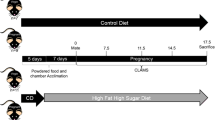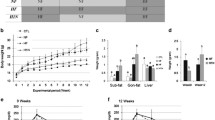Abstract
Objective
Tumor necrosis facto (TNF)-α is thought to mediate, in part, the link between obesity and insulin resistance, and women with gestational diabetes mellitus (GDM) have raised serum TNF-α concentrations. Our objective was to investigate whether systemic TNF-α administration into gravid C57BL6/J mice causes a GDM-like syndrome and affects growth and adipose tissue (AT) development in the offspring.
Methods
We assessed glucose tolerance and reproductive outcome in mice infused with saline, or 2 μg or 4 μg recombinant mouse (rm)TNF-α by subcutaneous mini-osmotic pumps between days (d)11.5 and 18.5 of gestation. Subsequently, we studied the effects of the 2-μg dose on maternal AT metabolism. Finally, the growth of offspring exposed to 2 μg rmTNF-α in utero was followed until 8 weeks postnatal age. At 8 weeks, we assessed AT accumulation, as well as adipocyte area in white AT and insulin sensitivity in males, and adipokine mRNA levels in various AT depots in females.
Results
The peak glucose response to an intraperiotneal glucose in late-gravid mice and fetal weight were higher with 2 μg but not 4 μg rmTNF-α compared with saline; however, 2 μg TNF-α did not affect AT parameters. The female but not male offspring of these mice showed accelerated growth, hyperadiposity, robustly increased leptin expression in all AT depots, and raised fasting blood glucose.
Conclusions
TNF-α infusion (2 μg for 7 days) in gravid mice resulted in a mild GDM syndrome and accelerated AT development in the offspring in a sex-specific manner. The data suggest that TNF-α mediates in part the effects of GDM on fetal growth and postnatal adiposity, and constitutes a potential mediator of intrauterine programming.
Similar content being viewed by others

References
Hotamisligil GS, Shargill NS, Spiegelman BM. Adipose expression of tumor necrosis factor-α: Direct role in obesity-linked insulin resistance. Science 1993;259:87–91.
Winkler G, Kiss S, Keszthelyi L, et al. Expression of tumor necrosis factor (TNF)-α in the subcutaneous and visceral adipose tissue in correlation with adipocyte cell volume, serum TNF-α, soluble serum TNF-receptor-2 concentrations and C-peptide level. Eur J Endocrinol 2003;149:129–135.
Weisberg SP, McCann D, Desai M, Rosenbaum M, Leibel RL, Ferrante AW. Obesity is associated with macrophage accumulation in adipose tissue. J Clin Invest 2003;112:1796–1808.
Cinti S, Mitchell G, Barbatelli G, et al. Adipocyte death defines macrophage localization and function in adipose tissue of obese mice and humans. J Lipid Res 2005;46:2347–2355.
Hotamisligil GS, Arner P, Caro JF, Atkinson RL, Spiegelman BM. Increased adipose tissue expression of tumor necrosis factor-α in human obesity and insulin resistance. J Clin Invest 1995;95:2409–2415.
You T, Yang R, Lyles MF, Gong D, Nicklas BJ. Abdominal adipose tissue cytokine gene expression: Relationship to obesity and metabolic risk factors. Am J Physiol Endocrinol Metab 2005;288:E741–E747.
Koistinen HA, Bastard JP, Dusserre E, et al. Subcutaneous adipose tissue expression of tumour necrosis factor-α is not associated with whole body insulin resistance in obese nondiabetic or in type-2 diabetic subjects. Eur J CLin Invest 2000;30:302–310.
Feinstein R, Kanety H, Papa MZ, Lunenfeld B, Karasik A. Tumor necrosis factor-alpha suppresses insulin-induced tyrosine phosphorylation of insulin receptor and its substrates. J Biol Chem 1993;268:26055–26058.
Lieu LS, Spelleken M, Rohrig K, Hauner H, Eckel J. Tumor necrosis factor-alpha acutely inhibits insulin signaling in human adipocytes: Implication of the p80 tumor necrosis factor receptor. Diabetes 1998;47:515–522.
del Aguila LF, Claffey KP, Kirwan JP. TNF-α impairs insulin signaling and insulin stimulation of glucose uptake in C2C12 muscle cells. AM J Physiol Endocrinol Metab 1999;276:E849–E855.
MacDougald OA, Mandrup S. Adipogenesis: Forces that tip the scales. Trends Endocrinol Metab 2002;13:5–11.
Qian H, Hausman DB, Compton MM, et al. TNF-α induces and insulin inhibits capase 3-dependent adipocyte apotosis. Biochem Biophys Res COmmun 2001;284:1176–1183.
Green A, Rumberger JM, Stuart CA, Ruhoff MS Stimulation of lipolysis by tumor necrosis factor-α in 3T3-L1 adipocytes is glucose dependent: Implications for long-term regulation of lipolysis. Diabetes 2004;53:74–81.
Bays H, Mandrino L, DeFronzo RA, Role of the adipocyte, free fatty acids, and ectopic fat in pathogenesis of type 2 diabetes mellitus: Peroxisomal proliferator-activated receptor agonists provide a rational therapeutic approach. J Clin Endocrinol Metab 2004;89:463–478.
Finck BN, Johnson RW. Tumor necrosis factor (TNF)-α induces leptin production through the p55 TNF receptor. Am J Physiol Regul Integr Comp Physiol 2000;278:R537–R543.
Daviaud D, Boucher J, Gesta S, et al. TNFα up-regulates apelin expression in human and mouse adipose tissue. FASEB J 2006;20:1528–1530.
Ruan H, Miles PD, Ladd CM, et al. Profiling gene transcription in vivo reveals adipose tissue as an immediate target of tumor necrosis factor-α: Implications for insulin resistance. Diabetes 2002;51:3176–3188.
Fasshauer M, Klein J, Neumann S, Eszlinger M, Eszlinger M, Paschke R. Tumor necrosis factor α is a negative regulator of resistin gene expression and secretion in 3T3-L1 adipocytes. Biochem Biophys Res Commun 2001;288:1027–1031.
Xu H, Hirosumi J, Uysal KT, Guler AD, Hotamisligil GS. Exclusive action of transmembrane TNFα in adipose tissue leads to reduced adipose mass and local but not systemic insulin resistance. Endocrinology 2002;143:1502–1511.
Plomgaard P, Bouzakri K, Krogh-Madsen R, Mittendorfer B, Zierath JR, Pedersen BK. Tumor necrosis factor-α induces skeletal muscle insulin resistance in healthy human subjects via inhibition of Akt substrate 160 phosphorylation. Diabetes 2005;54:2939–2945.
Lang CH, Dobrescu C, Bagby GJ. Tumor necrosis factor impairs insulin action on peripheral glucose disposal and hepatic glucose output. Endocrinology 1992;130:43–52.
Kitwin JP, Haugel-De Mouzon S, Lepercq J, et al. TNF-α is a predictor of insulin resistance in human pregnancy. Diabetes 2002;51:2207–2213.
Winkler G, Cseh K, Baranyi E, et al. Tumor necrosis factor system in insulin resistance in gestational diabetes. Diabetes Res Clin Pract 2002:56:93–99.
Radaelli T, Varastehpour A, Catalano P, Hauguel-de Mouzon S. Gestational diabetes induces placental genes for chronic stress and inflammatory pathways. Diabetes 2003;52:2951–2958.
Verhaeghe J, van Bree R, Lambin S, Caluwaerts S. Adipokine profile and C-reactive protein in pregnancy: Effects of glucose challenge reponse versus body mass index. J Soc Gynecol Investig 2005;12:330–334.
McLachlan KA, O’Neal D, Jenkins A, Alford FP. Do adiponectin, TNFα, leptin and CRP relate to insulin resistance in pregnancy? Studies in women with and without gestational diabetes, during and after pregnancy. Diabetes Metab Res Rev 2006;22:131–138.
Chen HL, Yang YP, Hu XL, Yelavarthi KK, Fishback JL, Hunt JS. Tumor necrosis factor alpha mRNA and protein are present in human placental and uterine cells at early and late stages of gestation. Am J Pathol 1991;139:327–335.
Franks PW, Looker HC, Kobes S, et al. Gestational glucose tolerance and risk of type 2 diabetes in young Pima Indian offspring. Diabetes 2006;55:460–465.
Dahlgren J, Nilsson C, Jennische E, et al. Prenatal cytokine exposure results in obesity and gender-specific programming. Am J Physiol Endocrinol Metab 2001;281:E326–E334.
Carbó N, López-Soriano FJ, Argilés JM. Tumour necrosis factor-α does not cross the rat placenta. Cancer Lett 1998;128:101–104.
Goren HJ, Kulkarni RN, Kahn CR. Glucose homesotasis and tissue transcript content of insulin signaling intermediates in four inbred strains of mice: C57BL/6, C57BLKS/6, DBA/2, and 129X1. Endocrinology 2004;145:3307–3323.
Rodbell M. Metabolism of isolated fat cells. I. Effects of hormones on glucose metabolism and lipolysis. J Biol Chem 1964;239:375–380.
Johnson MM, Peters JP. An improved method to quantify nonesterified fatty acids in bovine plasma. J Anim Sci 1993;71:753–756.
Cheung AT, Ree D, Kolls JK, Fuselier J, Coy DH, Bryer-Ash M. An in vivo model for elucidation of the mechanism of tumor necrosis factor-α (TNF-α)-induced insulin resistance: Evidence for differential regulation of insulin signaling by TNF-α. Endocrinology 1998;139:4928–4935.
Borst SE, Lee Y, Conover CF, Shek EW, Bagby GJ. Neutralization of tumor necrosis factor-α reverses insulin resistance in skeletal muscle but not adipose tissue. Am J Physiol Endocrinol Metab 2004;287:E934–E938.
Zhao YF, Feng DD, Chen C. Contribution of adipocyte-derived factors to beta-cell dysfunction in diabetes. Int J Biochem Cell Biol 2006;38:804–819.
Xiang AH, Peters RK, Trigo E, Kjos SL, Lee WP, Buchanan TA. Multiple metabolic defects during late pregnancy in women at high risk for type 2 diabetes. Diabetes 1999;48:848–854.
Silen ML, Firpo A, Morgello S, Lowry SF, Francus T. Interleukin-1α and tumor necrosis factor α cause placental injury in the rat. Am J Pathol 1989;135:239–244.
Langer O, Damus K, Maiman M, Divon M, Levy J, Bauman W. A link between hypoglycemia-hypoinsulinemia during oral glucose tolerance tests and intrauterine growth retardation. Am J Obstet Gynecol 1986;155:711–716.
Corica F, Allegra A, Corsonello A, et al. Relationship between plasma leptin levels and the tumor necrosis factor-α system in obese subjects. Int J Obes 1999;23:355–360.
Neels JG, Pandey M, Hotamisligil GS, Samd F. Autoamplification of tumor necrosis factor-α: A potential mechanism for the maintenance of elevated tumor necrosis factor-α in male but not female obese mice. Am J Pathol 2006;168:435–444.
Kirchgessner TG, Uysal KT, Wiesbrock SM, Marino MW, Hotamisligil GS. Tumor necrosis factor-α contributes to obesity-related hyperleptinemia by regulating leptin release from adipocytes. J Clin Invest 1997;100:2777–2782.
Guo K-Y, Halo P, Leibel RL, Zhang Y. Effects of obesity on the relationship of leptin mRNA expression and adipocyte size in anatomically distinct fat depots in mice. Am J Physiol Regul Integr Comp Physiol 2004;287:R112–R119.
Boucher J, Masri B, Daviaud D, et al. Apelin, a newly identified adipokine up-regulated by insulin and obesity. Endocrinology 2005;146:1764–1771.
Rajala MW, Qi Y, Patel HR, et al. Regulation of resistin expression and circulating levels in obesity, diabetes, and fasting. Diabetes 2004;53:1671–1679.
Zaretsky MV, Alexander JM, Byrd W, Bawdon RE. Transfer of inflammatory cytokines across the placenta. Obstet Gynecol 2004;103:546–550.
Aaltonen R, Heikkinen T, Hakala K, Laine K, Alanen A. Transfer of proinflammatory cytokines across term placenta. Obstet Gynecol 2005;106:802–807.
Ruan H, Hacohen N, Golub TR, Van Parijs L, Lodish HF. Tumor necrosis factor-α suppresses adipocyte-specific genes and activates expression of preadipocyte genes in 3T3-L1 adipocytes: Nuclear factor-kappaB activation by TNF-α is obligatory. Diabetes 2002;51:1319–1336.
Gillman MW, Rifas-Shiman S, Berkey CS, Field AE, Colditz GA. Maternal gestational diabetes, birth weight, and adolescent obesity. Pediatrics 2003;111:e221–e226.
Schaefer-Graf U, Pawliczak J, Passow D, et al. Birth weight and parental BMI predict overweight in children from mothers with gestational diabetes. Diabetes Care 2005;28:1745–1750.
Author information
Authors and Affiliations
Corresponding author
Additional information
S.L. and this project were supported by grants from the Fonds voor Wetenschappelijk Onderzoek-Vlaanderen (Belgiumi), grant no. G.0221.03, and the Katholteke Universiteit Leuven, grant no. OT/02/48.
The authors thank E. Van Herck and L.Vercruysse for their help.
Rights and permissions
About this article
Cite this article
Lambin, S., van Bree, R., Vergote, I. et al. Chronic Tumor Necrosis Factor-α Infusion in Gravid C57BL6/J Mice Accelerates Adipose Tissue Development in Female Offspring. Reprod. Sci. 13, 558–565 (2006). https://doi.org/10.1016/j.jsgi.2006.09.001
Published:
Issue Date:
DOI: https://doi.org/10.1016/j.jsgi.2006.09.001



